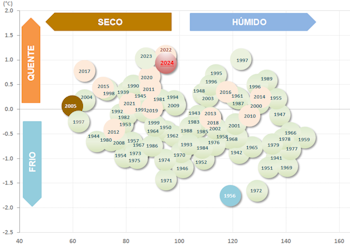News
-
Radar Network Covers the Whole Country
-
Improved Weather Forecasts
-
Summary Climatological Bulletin
satellite
SATELLITE | RADAR | LIGHTNING
The first satellites with operational applications were designed for meteorological support. Thus, the first satellite completely dedicated to meteorology, the polar orbiting TIROS (Television Infrared Observation Satellite) was launched by the USA on 1 April 1960. Meteorological satellites are designed for weather monitoring and can be divided into two different groups, according to their orbit:
-
a) Geosynchronous or geostationary satellites (GEO, Geostationary Earth Orbit). They are positioned over the plan of the equator at about 36,000 km altitude, on an orbit so calculated that the angular rotation speed of the satellite around the Earth is identical to the angular rotation speed of the Earth itself. This way, the instruments borne by these satellites always observe the same area of the Earth, and so they cover the polar regions rather poorly. On the other hand, they have the advantage that they can observe an Earth disk with a very short revisiting period, and so they are adequate to collect data from phenomena of very rapid evolution, as it is the case in meteorology. This is what happens with the satellites of the Meteosat series of EUMETSAT. The most recent of them, Meteosat 8, also known as Meteosat of Second Generation (MSG), bears on board instruments that can, not only monitor the weather conditions, but also supply data that are very useful to obtain surface parameters with higher accuracy and better resolution than those of previous series. Therefore, in spite of its distance from the surface, the time resolution of MSG is 15 minutes, with a spatial resolution of 3 km by 3 km over the vertical of the satellite (nadir).
- b) Heliosynchronous or polar orbiting satellites (LEO, Low Earth Orbit). They follow an orbit passing almost over the vertical of the poles at a much lower altitude, generally less than 1,000 km. The orbit of the American satellites of the NOAA series is at about 705 km altitude, with spatial resolutions of 1.1 km by 1.1 km over the nadir, but the revisiting period varies according to latitude. They ensure 2 passages a day, one on an ascending orbit (crossing the equator from south to north) and one on a descending orbit. As they are heliosynchronous, they cross the equator always at the same solar hour.
Several satellites of the NOAA series are currently in operation. As they bear equal instruments on board, they provide a better covering of the Earth, shortening the revisiting period as a whole. The launching of the first European orbital satellite (EPS - EUMETSAT Polar system) is expected to take place in 2006.




